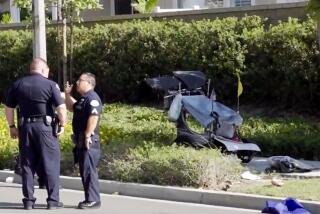DANA POINT : Self-Defense Argued in Slaying Case
- Share via
The attorney for a teen-ager accused of the fatal shooting of another teen-ager at a beach here argued Wednesday that he fired in self-defense because he feared that he was about to be severely beaten.
The statement from Deputy Public Defender Marri Derby came in the closing arguments of the trial of Christian Steffens, now 17. Steffens is charged with fatally wounding Rob Elliott, 18, from a distance of at least 33 feet on Sept. 8, 1990, after Elliott had chased him down the beach for at least 200 yards.
Derby argued that Steffens did not fire the gun until Elliott started to make another move toward him and only did so “because he feared he was about to get the crap beat out of him.”
“What was he (Steffens) supposed to do?” Derby asked. “Elliott is catching up with him. Elliott has not taken control of the situation. Christian doesn’t have to just accept getting beat up.”
But prosecutor Bernadette Cemore countered that the defendant was not “entitled to shoot somebody” by the circumstances.
Testimony indicated that Elliott and Steffens had had a fistfight at the beach earlier in the week and that two of Elliott’s friends had come later to Steffens’ school to threaten him.
Steffens told friends he was taking a pistol to Dana Strand beach to defend himself if Elliott started trouble.
Cemore argued to Juvenile Court Judge Francisco P. Briseno at the non-jury trial in Orange that Elliott was not doing anything when Steffens pulled the gun on him at the beach.
Witnesses at the scene agreed that Steffens put the gun down and started to walk away from the confrontation when Elliott began chasing him. Steffens fell to his knees eventually, and Elliott stopped chasing at the same time.
The prosecutor also argued that the defense is wrong in saying that Elliott started the chase again just before Steffens fired the gun.
“That is pure speculation,” Cemore said. “He had a gun pointed at him. He may have been foolhardy, but he wasn’t stupid.”
She also argued that several seconds elapsed while the two were stopped, giving Steffens time to form the intent to kill.
The closing arguments included the playing of two dramatic videotapes. One was a police interview with Steffens after the shooting, in which he broke down after learning that Elliott had died.
The second was a few seconds of the beach confrontation--taken before the chase began--and shot by a man who had taken his video camera to the beach to record his son on his surfboard. The tape shows Steffens looking up with his gun pointed at Elliott, who was standing above him on a bluff with friends.
The witness then turned his camera away from the confrontation to continue recording the surfers.
Briseno said he will announce his decision on the case Friday. If convicted of first- or second-degree murder, Steffens would be sent to the California Youth Authority, where he would probably serve about seven years, but no longer than his 25th birthday.
If he is found guilty of voluntary manslaughter, he would receive a four-year sentence, and two years if convicted of involuntary manslaughter.
Derby is seeking a not-guilty verdict based on self-defense.
More to Read
Sign up for Essential California
The most important California stories and recommendations in your inbox every morning.
You may occasionally receive promotional content from the Los Angeles Times.













